MAB and OECMs: A Local and Global Opportunity | 5th WCBR Side Event
MAB and OECMs—Opportunities and Challenges for Building an Inclusive, Connected, Representative, and Effective Conservation Network
On September 23, the side event themed “MAB and OECM: A Local and Global Opportunity” was held in Hangzhou as part of the 5th World Congress on Biosphere Reserves (WCBR). This event brought together Chinese and international experts in the conservation field and representatives of biosphere reserves to explore the opportunities and challenges for the synergistic development of biosphere reserves and OECMs. Through interpretation on the OECM concept and China’s potential and practices, the side event aimed to promote the OECM concept within the Man and the Biosphere (MAB) network, explore the potential and feasible pathways for biosphere reserves and their surrounding areas to become OECMs, facilitate international experience exchange on OECM identification and management, and explore collaborative opportunities to support the development of OECMs both in China and globally.
The side event was hosted by IUCN WCPA OECMs Specialist Group and co-organized by IUCN China Office, Chinese Research Academy of Environmental Sciences, South China Agricultural University, and Shan Shui Conservation Center. The side event has received support from the OECM Policy Dialogue Project launched and implemented under the China Biodiversity Facility (CBF), a European Union grant managed by AFD in close coordination with relevant Chinese ministries. The Global Environment Facility (GEF) also provides support to this side event.

Side event venue
Opening Remarks
In his opening remarks, Wang Yi, Member of the Standing Committee of the National People’s Congress, Director and Researcher of the Carbon Neutrality Research Center at the Chinese Academy of Sciences’ Institute of Strategic Studies, pointed out that biodiversity conservation requires not only the strength of national governments but also the participation of a broader range of social forces. OECMs provide an important avenue for diverse stakeholders to participate in and support biodiversity conservation. He emphasized that the development of OECMs needs to combine top-down institutional arrangements with bottom-up practical explorations. From the top-down perspective, the newly enacted National Park Law has laid the institutional foundation for public participation, but further clarification of institutional arrangements in the OECM field is still needed to advance the identification and management of OECMs. From the bottom-up practice level, there is currently no OECM model that can be directly applied. It is necessary to continuously explore, summarize, and distill best practices and experiences from a large number of conservation practices, and on this basis, promote the formulation and improvement of OECM standards, technical regulations, and related systems. Wang Yi looks forward to deepening OECM practices in China and sharing the experiences of China and other countries with more nations through South-South and South-North-South cooperation to jointly support OECMs in achieving their original targets and realizing the long-term goals of biodiversity conservation.
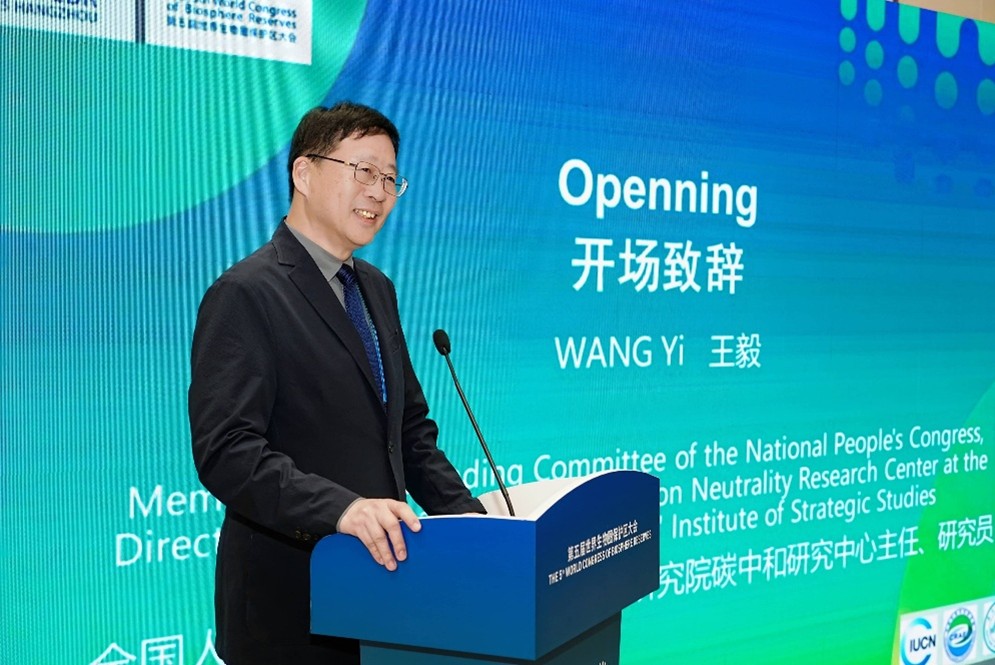
Wang Yi delivered opening remarks
Xu Zhihong, Academician of the Chinese Academy of Sciences and Chairman of the Expert Advisory Committee of the China National Committee for MAB, attended the side event and delivered remarks. He stated that biodiversity conservation requires the participation of the entire society, including communities, enterprises, and the general public. While China’s rapid economic development has had impacts on the natural environment, many nature reserves have been established and have achieved significant conservation outcomes. However, conservation work still faces many gaps and challenges. The choice of Hangzhou to host the 5th WCBR aims to explore how economically developed areas can achieve harmonious development between humans and nature. Xu Zhihong emphasized the need to mobilize the public to establish a conservation mindset and engage in nature conservation. For example, encouraging enterprises to inject more financial support into conservation efforts, coordinating and mobilizing community members to improve livelihoods while protecting the environment, and cultivating the love and understanding of nature among young people and the general public through nature education, in order to truly internalize the concept of conservation. He encouraged all parties to jointly participate in conservation efforts.
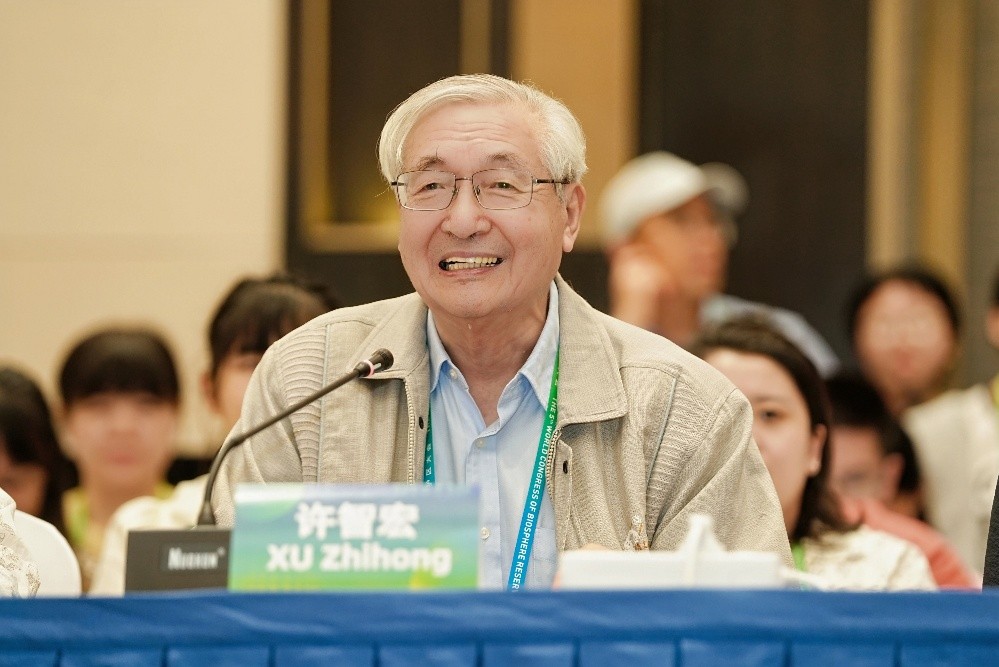
Xu Zhihong delivered remarks
Keynote speech
Mitali Sharma, Asia Co-chair, IUCN WCPA OECMs Specialist Group introduced the concept, criteria, and assessment tools of OECMs, as well as the global development status. She provided a detailed interpretation of the opportunities and challenges facing OECMs and pointed out the need to distinguish between Target 3 and Target 10 of the Kunming-Montreal Global Biodiversity Framework (GBF). OECMs, as part of Target 3 (the 30×30 Target), allow non-extractive and low-intensity use, and their sustainable use must be consistent with conservation. In contrast, more extensive eco-friendly sustainable agricultural, forestry, and fishery practices may not fit the OECM concept and are more suitable for contributing to Target 10. Mitali Sharma analyzed the differences and connections between biosphere reserves and OECMs from the dimensions of primary aims, zonation, governance, international recognition, and monitoring and threat management. She proposed that the buffer zones and transition zones of biosphere reserves outside existing protected areas have the potential to become OECMs if they support important biodiversity values, but specific assessments should be conducted on a case-by-case basis.
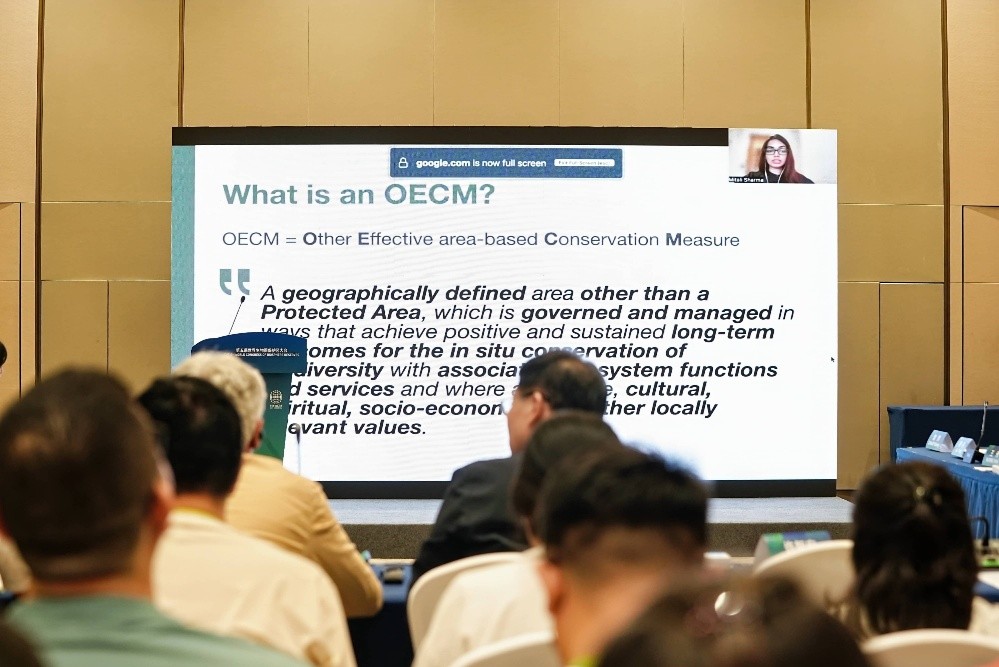
Mitali Sharma introduced OECM concept and its relationship with biosphere reserves
Lu Zhi, Professor at Peking University, analyzed the three approaches for achieving the 30×30 Target: protected areas (PAs), OECMs, and indigenous and traditional territories (ITTs), noting that ITTs may overlap spatially with protected areas and OECMs. From the perspectives of ecosystems and species, she analyzed the existing gaps in the protection of important ecological areas through current protected areas and ecological conservation redline in China. She pointed out that OECMs can play a positive role in filling these gaps and enhancing the connectivity of conservation networks, providing feasible conservation strategies for areas in eastern and southern China with high population pressure, rich biodiversity, and relatively fragmented habitats, while also supporting bottom-up conservation efforts. The conservation increment brought by OECMs gives them the potential to become biodiversity financing tools and attract more social capital investment in conservation. The first batch of potential OECM cases in China has preliminarily demonstrated the diverse and inclusive governance structure of potential OECMs and their significant conservation outcomes in species and ecosystem protection. Lu Zhi emphasized the urgent need to further promote OECM work from aspects such as mechanisms, policy, monitoring and evaluation, and financial support, and to establish a platform where bottom-up participation and top-down recognition and policy support each other to achieve the full development and wider application of OECMs.
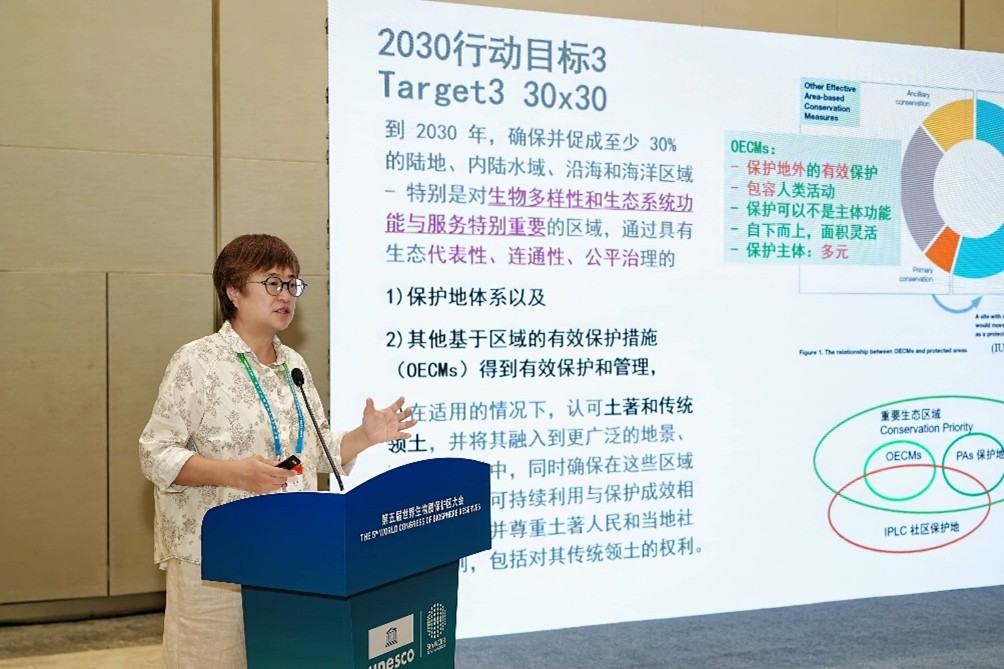
Lu Zhi analyzed the needs and gaps of OECMs in China
At the side event, multiple parties jointly launched the second round of the OECMs China Potential Case Collection.
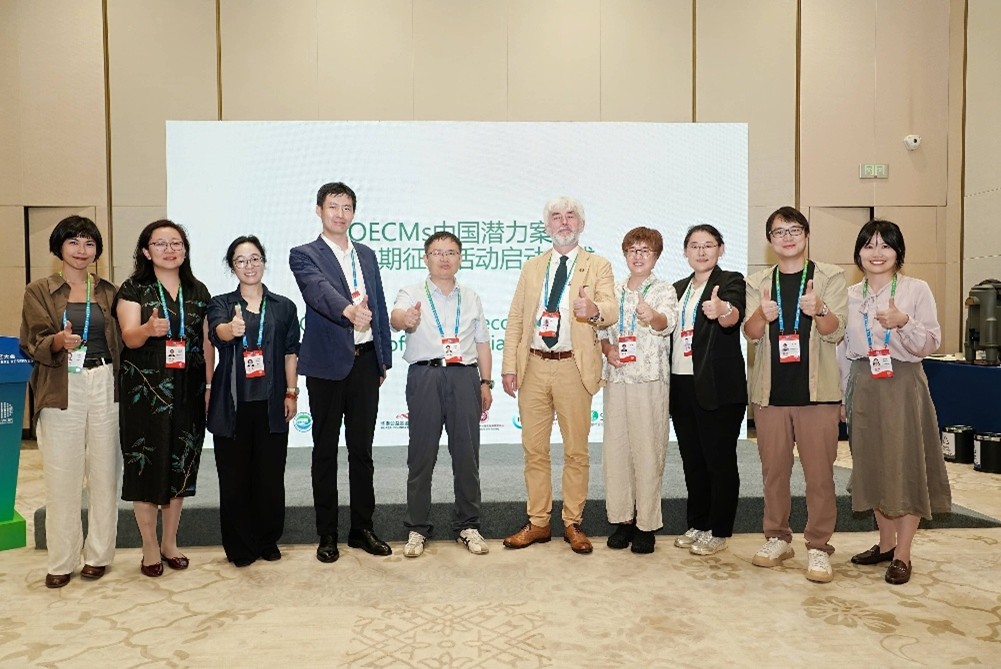
Kick-off ceremony for the second round of the OECMs China Potential Case Collection
Case studies
In the case-sharing session, conservation practitioners and experts from China and around the globe explored the potential integration points between existing conservation efforts and OECMs, ranging from macro-level national and regional planning and potential assessment to micro-level conservation practices at the case scale.
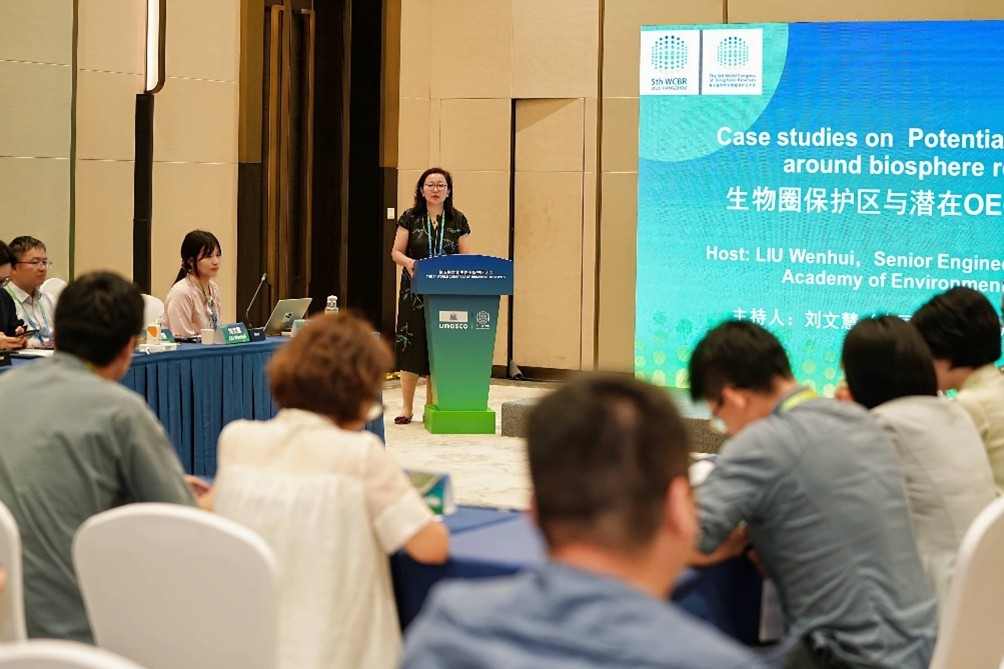 Liu Wenhui, Senior Engineer at the Chinese Research Academy of Environmental Sciences, hosted the case study session
Liu Wenhui, Senior Engineer at the Chinese Research Academy of Environmental Sciences, hosted the case study session
Hao Zhiming, Project Manager of the UNDP-GEF Flyway Conservation Network at the Academy of Forestry Inventory and Planning of the National Forestry and Grassland Administration, introduced the “China Action Plan for the Protection and Restoration of Migratory Bird Flyways (2024—2030)” released by the National Development and Reform Commission, the Ministry of Finance, and the National Forestry and Grassland Administration in 2024. The plan sets an action target of incorporating 90% of the key habitats of migratory bird flyways into effective protection. Among the 821 key habitats identified so far, 144 have not yet been assigned a clear form of protection and await exploration through OECMs and the involvement of a broader range of social actors to fill the protection gap. He also introduced the progress and achievements of the UNDP-GEF Flyway Conservation Network project in promoting policy-making, building and enhancing protected area networks, constructing demonstration conservation sites, and conducting publicity and knowledge management.
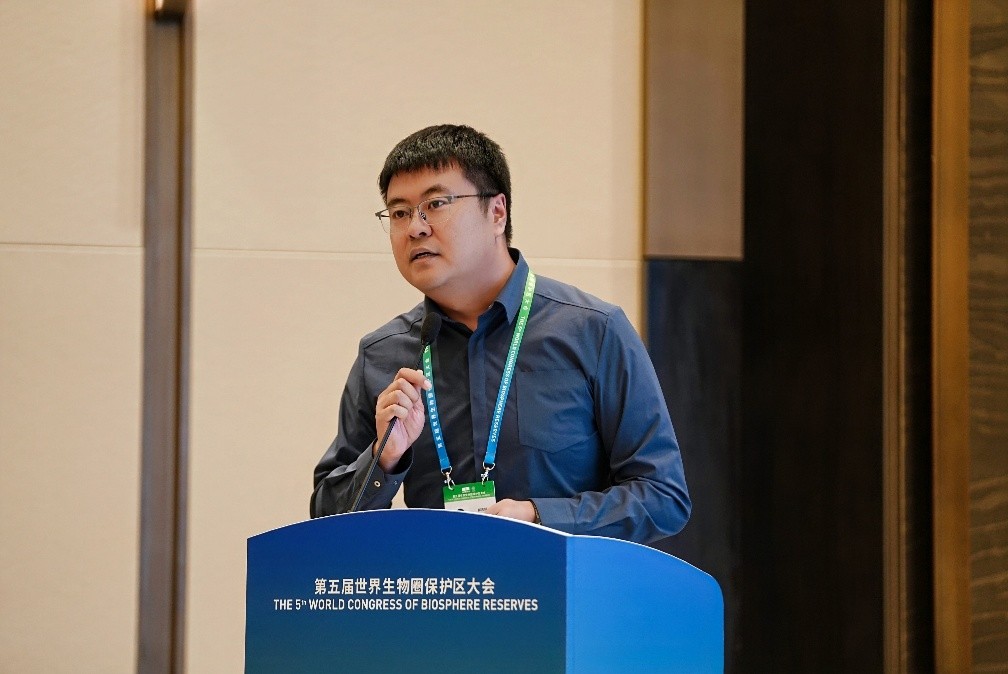 Hao Zhiming introduced Flyway Conservation Network and the potential contributions of OECMs
Hao Zhiming introduced Flyway Conservation Network and the potential contributions of OECMs
Zeng Xiwen, Deputy Director of Research Center for Ecological and Environmental Protection, Yunnan Academy of Ecological and Environmental Sciences, shared the assessment results of biodiversity conservation contributions of potential OECMs in Yunnan Province. Protected areas in Yunnan account for 14% of the province’s land area, while 12 types of potential OECM areas outside protected areas, including ecological conservation redline, important wetlands, public welfare forests, natural forests, and drinking water source protection zones, account for 51% of the province’s area. Adding up PAs and OECMs, the effective conservation coverage can reach 66%. After incorporating potential OECMs, the landscape connectivity index of the conservation network increased by 13 times, and 28 extremely small populations and 34 important germplasm resources were effectively covered, fully demonstrating the conservation effectiveness of potential OECMs. Zeng Xiwen stated that in the future, efforts will be made to further promote OECM pilots, strengthen synergy with community cultural diversity, develop localized standards and recognition management systems, build institutionalized financial support mechanisms, and enhance publicity to promote the implementation and development of OECMs in Yunnan Province.
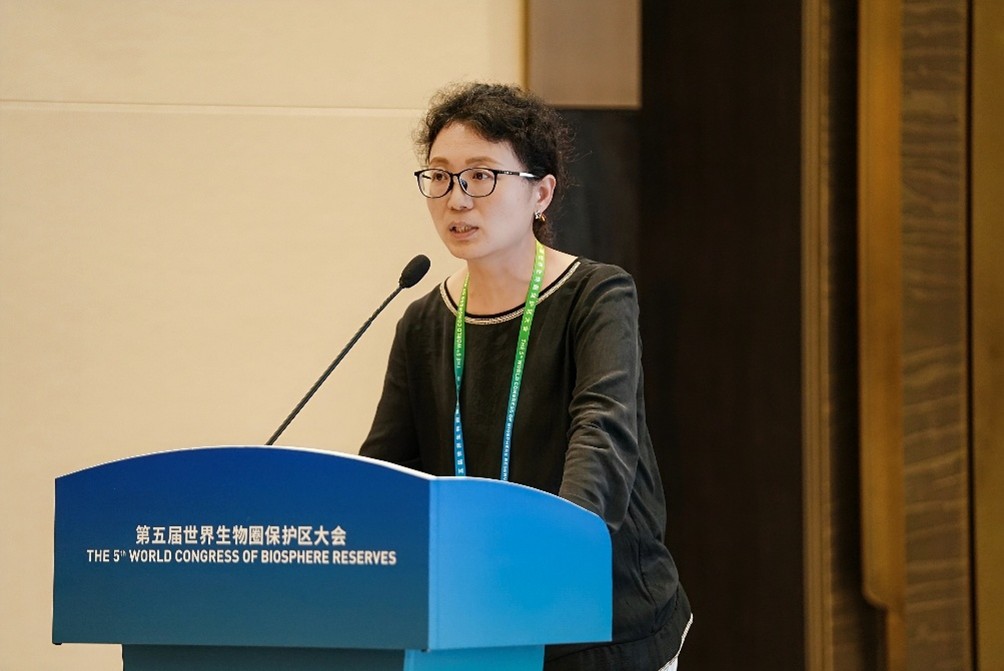
Zeng Xiwen introduced assessment of conservation contributions of potential OECMs in Yunnan Province
Daria Petrova from IRBIS Association Russia introduced their work in organizing scientists, volunteers, local communities, and rangers to conduct snow leopard surveys across Russia’s snow leopard distribution areas. In fact, a significant portion of snow leopard habitats lies outside protected areas in Russia, and OECMs provide a means of recognition and further strengthening for snow leopard conservation in these regions. Additionally, in the protected areas and their surroundings where snow leopards are distributed, local communities face the serious problem of snow leopards preying on livestock. IRBIS has attempted prey compensation programs to alleviate human-wildlife conflicts and increase community tolerance, thereby preventing retaliatory killings. Meanwhile, IRBIS also conducts activities such as creating promotional videos, organizing exhibitions, staging children’s theater, and implementing school education programs to reach a wider audience with snow leopard conservation messages.
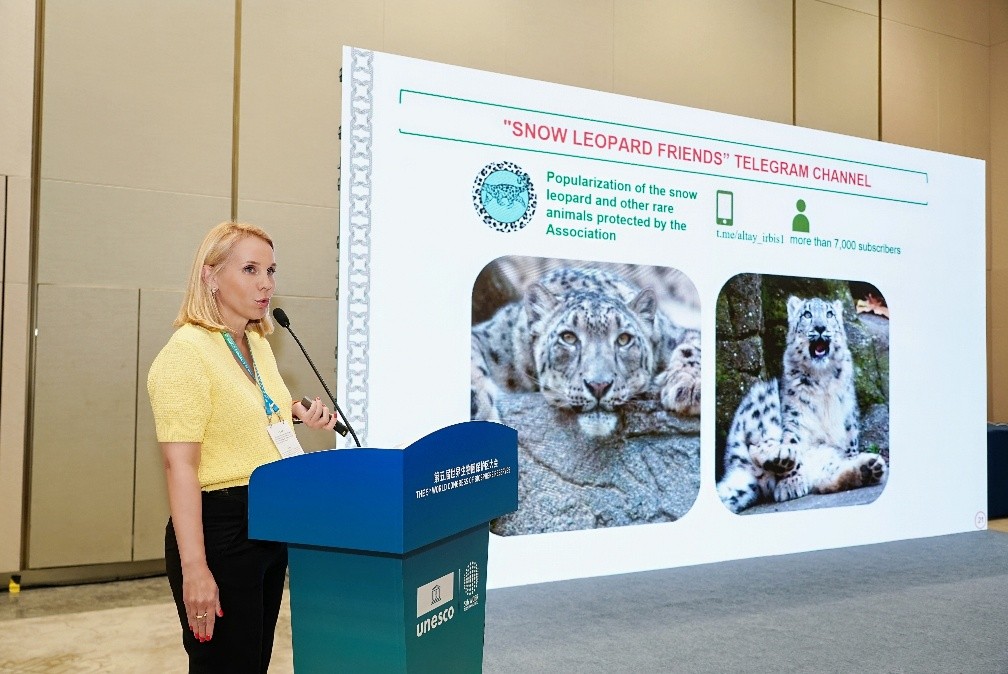 Daria Petrova introduces snow leopard conservation efforts in Russia
Daria Petrova introduces snow leopard conservation efforts in Russia
Zuo Shunjun, Deputy Director of Yunlongtianchi National Nature Reserve Administration, shared the preliminary exploration of OECMs in Wubaoshan Conservation Area. The Yunlong Tianchi Nature Reserve has Yunnan snub-nosed monkey troops in both its northern and southern sections. To promote communication between these troops, the reserve launched the “Monkey Bridge” project in 2019, which involved planting 8,988 acres of spruce, fir, and Armand pine in potential corridor areas to gradually restore forest connectivity. In 2023, the reserve in collaboration with multiple parties, established the Wubaoshan Conservation Area in the corridor region. This area has since carried out a series of actions, including systematic monitoring, regular patrols, eco-product development, and nature-based experiences as part of sustainable livelihood exploration. It also focuses on community capacity building, popular science propaganda, and scientific research. Zuo Shunjun introduced the experiences of Wubaoshan in clarifying conservation objectives, collaborative governance among multiple stakeholders, respecting and utilizing local ecological wisdom, and long-term empowerment of conservation entities. These experiences provide valuable references and insights for more regions to explore OECMs.
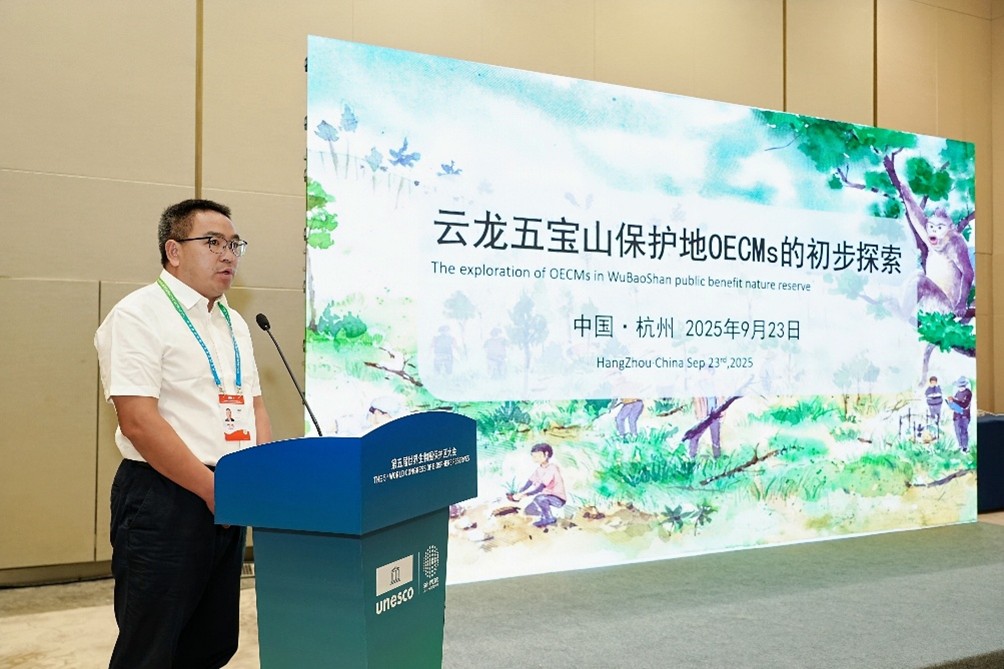 Zuo Shunjun shared the exploration of OECMs in Wubaoshan, Yunnan Province
Zuo Shunjun shared the exploration of OECMs in Wubaoshan, Yunnan Province
Wang Fang, Professor at Fudan University, believes that OECMs, as localized efforts, are inspirational and can drive exploration of significant issues while bringing about demonstrative and systemic innovations that catalyze broader conservation actions. He pointed out that China’s vast planted forests, typically located outside protected areas, currently have limited capacity to support biodiversity. However, with their mature management practices and professional forestry workers, these forests hold potential to become OECMs, yet still requires additional biodiversity knowledge, external scientific support, and science-based design. Wang Fang shared his experience in promoting biodiversity conservation and potential OECM development in six forestry farms within the habitat range of the North China leopard in Ningxia, Hebei, and Shanxi. The first step is to identify common interests or benefits. The forestry farms need to embrace biodiversity as a new growth point, but they currently lack monitoring and data, necessitating enhanced personnel capabilities and scientific planning. The involvement of research teams can provide scientific guidance and actionable recommendations for refined forest management through surveys and studies on species distribution, diet, and community structure. Implementation measures such as replanting, natural regeneration, and microhabitat quality improvement have achieved good conservation results. Wang Fang expressed his hope for forest farms to explore biodiversity-oriented practices under the OECM framework with external scientific support and to develop replicable and scalable forest management models to promote biodiversity transformation in a broader range of planted forests.
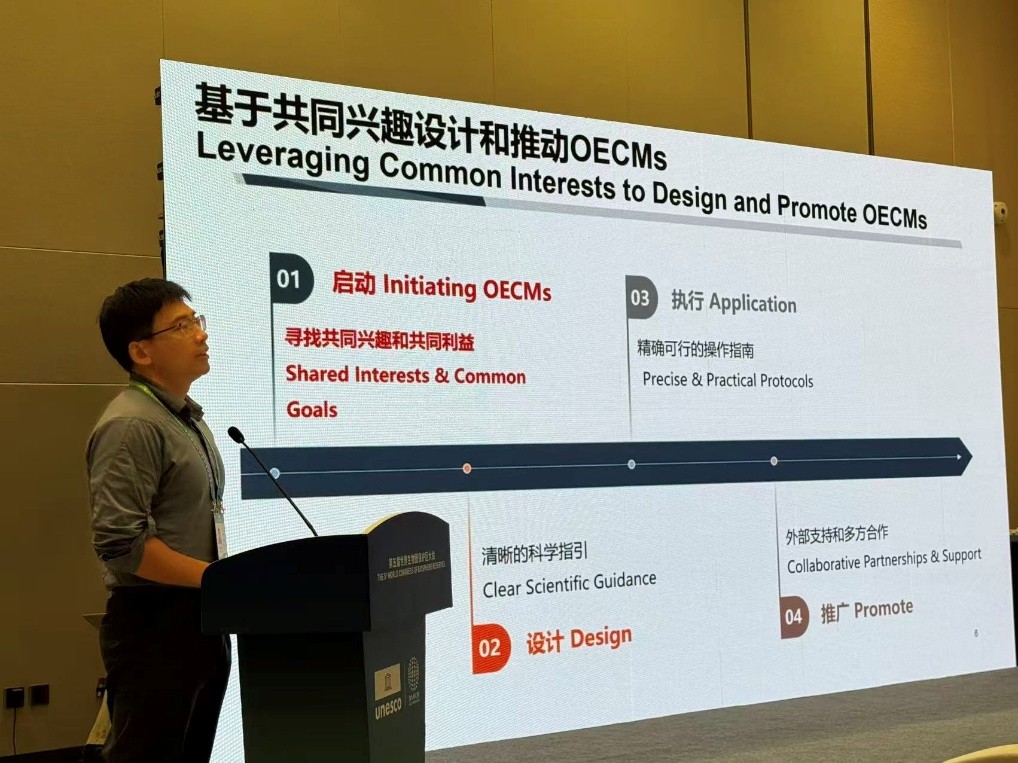 Wang Fang introduced biodiversity-oriented and OECMs-based forest enhancement
Wang Fang introduced biodiversity-oriented and OECMs-based forest enhancement
Yan Baohua, Secretary General at Mangrove Conservation Foundation, explored the importance of OECMs in filling the conservation gaps in the East Asian-Australasian Flyway (EAAF) using spoon-billed sandpiper as an example. Joint survey results indicate that only 15.07% of the suitable habitat for spoon-billed sandpiper globally is located within protected areas. Therefore, OECMs are an essential means of protecting migratory waterbirds like spoon-billed sandpiper. Yan Baohua shared potential OECM cases in Yancheng’s Tiaozini and Zhanjiang’s Wuchuan. In the Tiaozini Wetland of the Yellow Sea-Bohai Sea Migratory Bird Habitat World Heritage Site, since 2020, Mangrove Conservation Foundation (MCF), East Asian-Australasian Flyway Research Center of Beijing Forestry University (CEAAF), and the local government have collaborated to restore 720 acres of fish ponds within the dike as high-tide roost habitats and conducted scientific research, monitoring, and public education. Monitoring results show that this area plays a vital supporting role for spoon-billed sandpipers and other waterbirds, while also highlighting that 720 acres are far from sufficient, with extensive needs to explore potential OECM conservation practices over a larger area. In Wuchuan, Zhanjiang, the Zhanjiang Birdwatching Association, MCF, and CEAAF have jointly established a spoon-billed sandpiper mini-reserve in the Jian River Delta and carried out regular monitoring, patrolling, and CEPA. Yan BaoHua expressed the expectation that with the support of all parties and experts, these potential OECM cases will be promoted to become truly standard-compliant OECMs and further jointly strengthen the protection network of migratory birds along the EAAF.
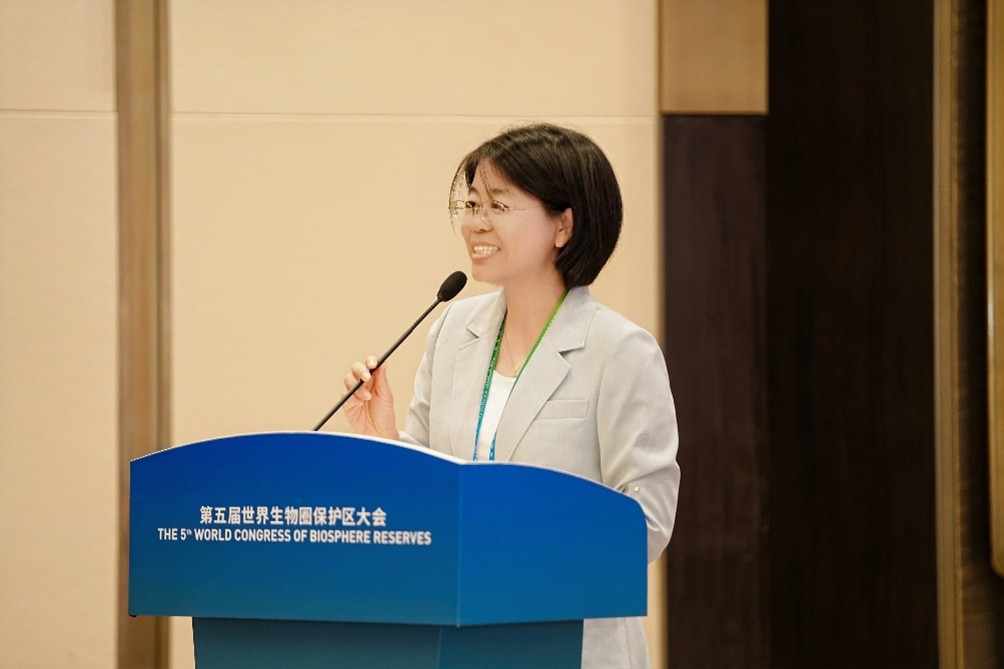 Yan Baohua explored the importance of OECMs in protecting migratory water birds such as spoon-billed sandpipers
Yan Baohua explored the importance of OECMs in protecting migratory water birds such as spoon-billed sandpipers
Panel discussion
During the roundtable discussion, experts from various fields jointly explored the potential synergies of biosphere reserves and other conservation mechanisms with OECMs, and put forward action recommendations to promote the long-term development of OECMs.
Tim Badman, Director of the World Heritage Team at IUCN, pointed out that biosphere reserves not only contribute to GBF Target 3, but also support the achievement of other GBF targets in multiple dimensions. Their approach aligns with OECMs in recognizing multiple values and respecting diversity. Biosphere reserves serve as an excellent experimental ground for understanding and testing the feasibility, scientific basis, inclusiveness, and multi-stakeholder recognition of OECM guidelines. He emphasized that going forward, biosphere reserves and OECMs need to further advance the process of obtaining consent and recognizing the stewardship and rights of local communities and relevant stakeholders, and ensure that biosphere reserves and OECMs contribute tangibly to significant conservation outcomes.
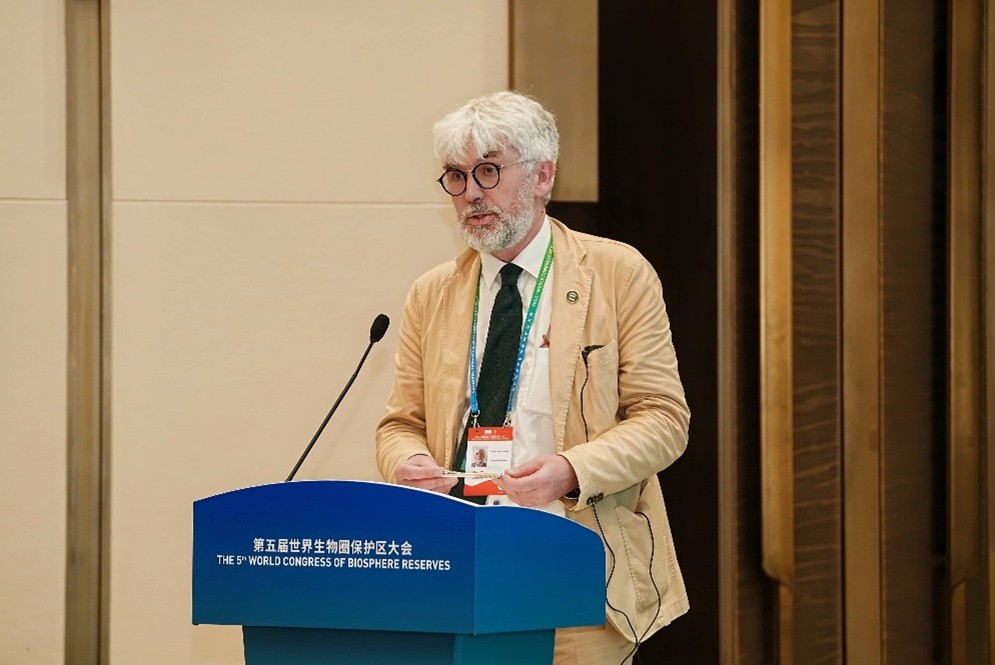 Tim Badman analyzed the relationship of biospheres and OECMs and their common challenges
Tim Badman analyzed the relationship of biospheres and OECMs and their common challenges
Wang Wei, Researcher at Chinese Research Academy of Environmental Sciences and Member of the Expert Advisory Committee of the China National Committee for MAB, interpreted the potential of Chinese biosphere reserves as OECMs. He noted that among China’s 34 biosphere reserves, 31 are established based on national nature reserves. Spatial overlay analysis reveals that about one-third of the biosphere reserves in China have completely consistent spatial boundaries and zonation with national nature reserves. Wang Wei’s team found that “the lower the proportion of a biosphere reserve covered by protected areas, the larger the area of the biosphere reserve, and the longer it has been part of the World Network of Biosphere Reserves, the more conducive it is to promoting coordinated development between human society and ecological conservation within the biosphere reserve.” Wang Wei suggested that in conjunction with the integration and optimization of protected areas, the zoning of biosphere reserves should be optimized. The core conservation areas of protected areas should be designated as the core zones of biosphere reserves, and the general control zones as buffer zones. Meanwhile, considering community development needs and local willingness and realities, the transition zones of biosphere reserves should be redefined and explore areas suitable for OECMs. He introduced that during the expansion process of the Tianmu Mountain-Qingliang Peak World Biosphere Reserve, functional zoning was carried out according to this model. The transition zone is currently conducting monitoring and protection of the national first-class protected wild plant, Phalaenopsis zhejiangensis, exploring potential OECM pilot demonstrations based on intelligent monitoring.
 Wang Wei analyzed the integration pathways of China’s biosphere reserves with protected areas and OECMs
Wang Wei analyzed the integration pathways of China’s biosphere reserves with protected areas and OECMs
Li Diqiang, Researcher at Chinese Academy of Forestry, stated that OECMs offer more possibilities for promoting inclusive conservation within China’s government-led conservation framework. He analyzed the relationship between key wildlife habitats and OECMs, pointing out the compatibility between the identification criteria of key wildlife habitats and the biodiversity value criteria of OECMs. China has released the first batch of 789 important wildlife habitats, about 10% of which are located outside protected areas. Li Diqiang suggested conducting pilot surveys and monitoring of the first batch of habitats to explore how to strengthen the management, monitoring, reporting, and assessment of key habitats in combination with the OECM approach, and to promote multi-stakeholder inclusive conservation, fully mobilizing the enthusiasm of local governments and all relevant stakeholders to participate in conservation.
 Li Diqiang discussed the relationship between key wildlife habtats and OECMs
Li Diqiang discussed the relationship between key wildlife habtats and OECMs
Zhao Zhicong, Associate Professor at Tsinghua University, pointed out that connectivity, as a qualitative indicator explicitly proposed in the 30×30 target, is another dimension for identifying gaps in the conservation network. The results of connectivity assessments of protected areas can serve as an important basis for OECM site selection. Research results from Zhao Zhicong’s team indicate that in eastern China, where habitat fragmentation is severe and protected area connectivity is poor, spatial analysis has identified many important corridor areas that could be supplemented by OECMs, contributing to both the enhancement of connectivity and expansion of conservation network. However, currently, the calculation of connectivity faces the challenge of lacking a unified methodology. The construction and governance process of OECMs based on connectivity still requires more efforts to ensure that conservation efforts can actually contribute to the connectivity of the conservation network and the improvement of biodiversity conservation quality.
 Zhao Zhicong emphasized the linkage between protected area connectivity analysis and OECM identification
Zhao Zhicong emphasized the linkage between protected area connectivity analysis and OECM identification
Hou Shuyu, Lecturer at South China Agricultural University, analyzed the potential and opportunities for establishing OECMs in the peripheral areas and corridors of protected areas. Taking Canada as an example, many OECMs in western and southern Canada effectively connect different protected areas. These areas, with relatively low human activity intensity, can well integrate conservation with local livelihoods, playing an important role in ecological connectivity. The “sky windows” of protected areas also hold significant value in becoming potential OECMs. In cities, OECMs are not only important ecological stepping stones but also have natural education functions. However, in the local promotion of OECMs in cities, there is a challenge in mobilizing the enthusiasm of conservation management entities. Measures such as financial resource mobilization, joint efforts from all parties to form a community of action, and strengthened policy guidance and support, are needed to encourage more urban green space management entities to join the OECM network. Hou Shuyu shared the attempt to establish the Greater Bay Area University Biodiversity Network in order to facilitate cooperation and exchange between school associations, hoping to fully utilize students’ interest and motivation to conduct monitoring surveys, natural education, and public promotion at a lower cost, while attracting more attention and participation from the broader public in OECM and urban biodiversity conservation.
 Hou Shuyu shared case studies on the connectivity of conservation networks through OECMs and conservation practices of potential OECMs in cities
Hou Shuyu shared case studies on the connectivity of conservation networks through OECMs and conservation practices of potential OECMs in cities
Jin Tong, Member of IUCN OECM China Expert Working Group, as the moderator of the panel discussion, summarized that although the concept of OECMs is relatively new, significant progress has been made compared to two or three years ago, with a series of studies and discussions enriching our understanding of the connotation and potential of OECMs in China. The experts present have put forward many suggestions and directions for the future development of OECMs, which are operable and implementable. Jin Tong expressed expectations for more significant achievements and new breakthroughs in the next stage through the joint efforts of all parties and hoped that data and experience accumulated from bottom-up practices could provide strong support for top-down policy-making.
 Jin Tong summarized panel discussion
Jin Tong summarized panel discussion
Closing remarks
In her closing remarks, Pauline Teillac-Deschamps, Biodiversity Task Team Leader of AFD, emphasized the potential of OECMs in international biodiversity cooperation. She noted that the China Biodiversity Facility (CBF) has provided an important platform for international exchanges and cooperation in the field of conservation between China, France and Europe. She called for a more comprehensive perspective in biodiversity conservation, focusing on ecosystem functions and services, as well as the interactions between biodiversity and human survival and development. Biosphere reserves and OECMs both offer such a perspective, balancing human well-being and biodiversity conservation to promote harmonious coexistence between humans and nature. She stressed the need to further integrate these concepts through learning, sharing, and caring, to incorporate people into the conservation framework and advance more inclusive conservation actions. Additionally, utilizing more financial tools to mobilize more resources in support of cost-effective conservation measures is crucial for the development of OECMs and biosphere reserves.
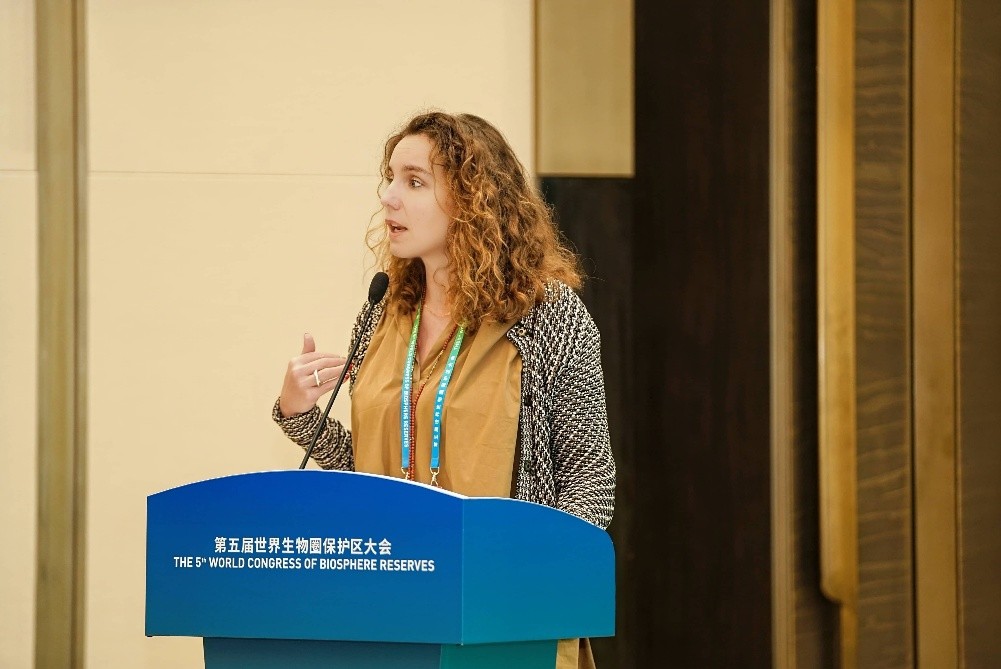 Pauline Teillac-Deschamps delivered closing remarks
Pauline Teillac-Deschamps delivered closing remarks
Summary
This side event brought together the wisdom and solid conservation practices of various parties, and deeply explored how to synergize biosphere reserves and other conservation mechanisms with OECMs to build an inclusive, connected, representative, and effective conservation network in a whole-of-government and whole-of-society manner. The potential integration points of OECMs shared by the participants with many existing conservation mechanisms (such as key habitats of migratory bird flyways, key wildlife habitats, important corridor areas between protected areas, and biodiversity enhancement in planted forests) have provided more possibilities for the identification and exploration of potential OECMs in China. Also, it is important to note that biosphere reserves and OECMs not only bring about biodiversity conservation outcomes, but also play multiple roles in respecting and safeguarding cultural diversity, inclusive and participatory governance, coordinated promotion of conservation and sustainable development, and mobilizing more extensive resources for biodiversity conservation.
Looking to the future, it is hoped that all parties will continue to play to their strengths and work together to advance the development of OECMs in China, from top-down policy promotion, mechanism exploration and spatial planning, to bottom-up community, public and stakeholder participation, formulation of refined conservation strategies based on scientific monitoring and research, and summarization and promotion of best practices. Meanwhile, we will promote broader international exchanges and knowledge-sharing, distilling and disseminating China’s practical experience, and drawing on lessons from other countries, to support the development of OECMs in China and globally, contributing to the achievement of GBF 30×30 target and other targets.
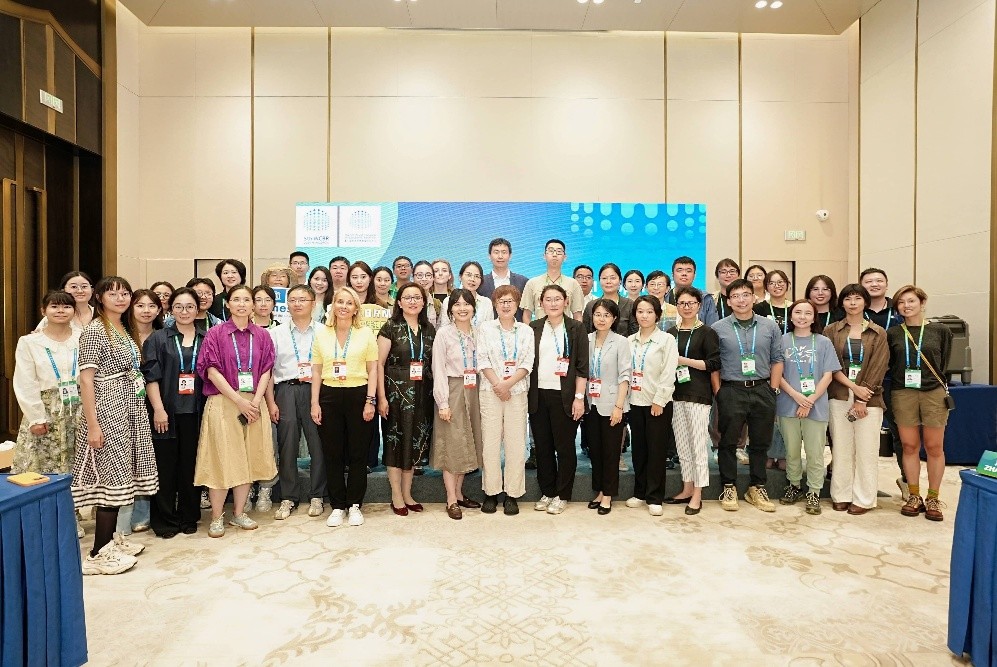 Side event group photo
Side event group photo


